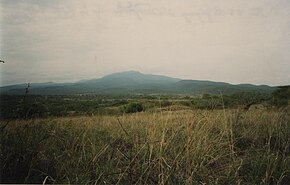Olorgesailie

Landscape near Olorgesailie
|
|
| Region | Eastern Rift Valley, Kenya |
|---|---|
| History | |
| Periods | Lower Paleolithic |
| Events | Acheulean hand axes |
Olorgesailie is a geological formation in East Africa containing a group of Lower Paleolithic archaeological sites. It is on the floor of the Eastern Rift Valley in southern Kenya, 40 miles (64 km) southwest of Nairobi along the road to Lake Magadi. Olorgesailie is noted for the large number of Acheulean hand axes discovered there that are associated with animal butchering. According to the National Museums of Kenya, the finds are internationally significant for archaeology, palaeontology, and geology.
The artefacts were first discovered by the British geologist John Walter Gregory in 1919, but it was not until 1943 that excavation began in earnest under the direction of Mary and Louis Leakey, with the assistance of paroled Italian prisoners of war. Work continued there until 1947. Glynn Isaac took up the excavation in the 1960s for his dissertation. In the 1980s, research was continued by Richard Potts of the Smithsonian Institution in conjunction with the National Museums of Kenya.
Human tools are the most prominent of all historic items in the area. The abundant hand axes are characteristic of the Acheulean period, made by hominins between about 600,000 and 900,000 years agoalong what was then the shore of a now dried-up lake. Fossils of various animals have also been found, including those of extinct species of hippo, elephant, zebra, giraffe, and baboon, likely to have been butchered with the aid of the hand axes.
...
Wikipedia
